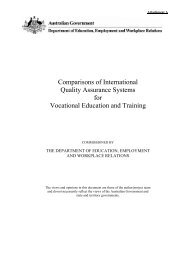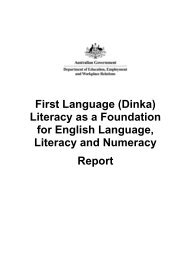National Survey of Research Commercialisation - Australian ...
National Survey of Research Commercialisation - Australian ...
National Survey of Research Commercialisation - Australian ...
Create successful ePaper yourself
Turn your PDF publications into a flip-book with our unique Google optimized e-Paper software.
In January 2001, the Prime Minister, John Howard, released his government’s statement<br />
on innovation, Backing Australia’s Ability: An Innovation Action Plan for the Future, which<br />
outlined the government’s strategy to encourage and support innovation, and enhance<br />
Australia’s international competitiveness, economic prosperity and social well being<br />
(Commonwealth <strong>of</strong> Australia, 2001). The statement announced a range <strong>of</strong> initiatives<br />
focusing on key elements <strong>of</strong> innovation, including:<br />
INTRODUCTION<br />
strengthening our ability to generate ideas and undertake research;<br />
accelerating the commercial application <strong>of</strong> ideas; and<br />
developing and retaining <strong>Australian</strong> skills.<br />
The initiatives in the statement are being funded by a government investment <strong>of</strong> $2.9<br />
billion over the five-year period 2001–02 to 2005–06 that will support business and<br />
research organisation expenditure <strong>of</strong> approximately $6 billion. Amongst the initiatives,<br />
and to help commercialise public sector research, the government is providing $79<br />
million in pre-seed funding to take proposals to venture-capital-ready stage.<br />
As part <strong>of</strong> an ongoing commitment to improving Australia’s innovative capacity in<br />
the longer term, the government also undertook to examine the barriers to, and the<br />
effectiveness <strong>of</strong>, current incentives for the commercialisation <strong>of</strong> government-funded<br />
research in Australia to, for example, increase the development <strong>of</strong> patents from scientific<br />
research by publicly funded institutions.<br />
Under the Prime Minister’s chairmanship, his Science, Engineering and Innovation<br />
Council (PMSEIC) has also prepared a series <strong>of</strong> working papers and reports on priority<br />
issues to improve Australia’s innovation performance. In June 2001, a PMSEIC report,<br />
Commercialising Public Sector <strong>Research</strong>, highlighted the need to improve Australia’s<br />
ability to turn great concepts into commercial success stories, so we all benefit from<br />
the returns on our research investment (Prime Minister’s Science, Engeineering and<br />
Innovation council, 2001). The report proposed that, if we can grow 200–250 more<br />
<strong>Australian</strong> research-based companies over the next five years, the prize could be around<br />
$20 billion added to our annual export earnings. The report urged that:<br />
Australia should aim for the world’s best practice in commercialisation. To do this we need<br />
to get serious about tracking our performance against the ‘best <strong>of</strong> the best’. We need to<br />
stretch upward and set high targets for increasing the current number <strong>of</strong> licenses generated<br />
and spin-<strong>of</strong>f companies created.<br />
The data contained in this report enable Australia, for the first time, to benchmark its<br />
performance against the ‘best <strong>of</strong> the best’ and, on that basis, to set targets for future<br />
performance which are not only aspirational, but realistic.<br />
THE SURVEY<br />
The objectives <strong>of</strong> the survey were to establish a methodology for measuring the<br />
commercial return on the public investment in research in Australia and to establish<br />
baselines against which to measure future performance and compare that performance<br />
with comparable activities overseas.<br />
15

















